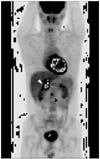Abstract
Pheochromocytoma is an uncommon neoplasm and it is derived from the neural crest. It is one of the surgically curable hypertensive syndromes. The sequela of this disease can be serious if definite treatment is not promptly performed. We report here on a case of malignant pheochromocytoma that recurred in the contralateral adrenal gland and it subsequently metastasized to the bladder after the patient refused treatment of the contralateral adrenal tumor.
Figures and Tables
Fig. 1
Abdominal computer tomography taken 10 years before presentation shows a well-defined round mass with peripheral marked enhancement and central necrosis in the anterior portion of the left kidney (white arrowhead).

Fig. 2
Microscopic finding of the left adrenal mass lesion that is resected 10 years before. It reveals pheochromocytoma and shows a small alveolar pattern of growth with balls or cords of cells ("Zellballen") that are delimited from each other by connective tissues and vascular septations. Mitotic figures are uncommonly seen (H&E, ×150).

Fig. 3
Abdominal computer tomography shows recurrent mass lesion involving the right adrenal gland (7.0×4.2×2.1cm, white arrowhead) (A) and enlargement of the aorto-caval lymph node (3.5×2.1×1.5cm, white arrowhead) (B).

Fig. 4
Pelvic computer tomography shows well-enhancing mass lesion between the posterior wall of the bladder and the seminal vesicle (2.8×1.9×1.8cm).

Fig. 5
18F-FDG PET shows increased uptakes in the right adrenal gland (white) and the aorto-caval lymph node (black).

References
1. Goldstein RE, O'Neill JA Jr, Holcomb GW III, Morgan WM III, Neblett WW III, Oates JA, et al. Clinical experience over 48 years with pheochromocytoma. Ann Surg. 1999. 229:755–764.
2. John H, Ziegler WH, Hauri D, Jaeger P. Pheochromocytomas: Can malignant potential be predicted? Urology. 1999. 53:679–683.
3. Noshiro T, Shimizu K, Watanabe T, Akama H, Shibukawa S, Miura W, et al. Changes in clinical features and long-term prognosis in patients with pheochromocytoma. Am J Hypertens. 2000. 13:35–43.
4. Lack EE. Lack EE, editor. Adrenal medullary hyperplasia and pheochromocytoma. Pathology of adrenal and extraadrenal paraganglia. Major problems in pathology. 1994. Philadelphia: WB Saunders;220–272.
5. Thompson LD. Pheochromocytoma of the Adrenal Gland Scaled Score (PASS) to separate benign from malignant neoplasms: a clinicopathologic and immunophenotypic study of 100 cases. Am J Surg Pathol. 2002. 26:551–566.
6. Stenstrom G, Svardsudd K. Pheochromocytoma in Sweden 1958-1981. An analysis of the National Cancer Registry Data. Acta Med Scand. 1986. 220:220–232.
7. Padmanabhan H, Ehrlich LD, Quazedo M, Fojo T, Louie A, Walther M, et al. Unusual locations of involvement by malignancies: case 2. Metastatic pheochromocytoma to the colon. J Clin Oncol. 2003. 21:3369–3371.
8. Lee YS, Oh KH. Clinical evaluation of 12 cases of pheochromocytoma. Korean J Urol. 1993. 34:619–625.
9. Mamede M, Carrasquillo JA, Chen CC, Corral PD, Whatley M, Ilias I, et al. Discordant localization of 2-[18F]-fluoro-2-deoxy-D-glucose in 6-[18F]-fluorodopamine- and [123I]-metaiodobenzylguanidine-negative metastatic pheochromocytoma sites. Nucl Med Commun. 2006. 27:31–36.
10. Brouwers FM, Petricoin EF 3rd, Ksinantova L, Breza J, Rajapakse V, Ross S, et al. Low molecular weight proteomic information distinguishes metastatic from benign pheochromocytoma. Endocr Relat Cancer. 2005. 12:263–272.




 PDF
PDF ePub
ePub Citation
Citation Print
Print




 XML Download
XML Download